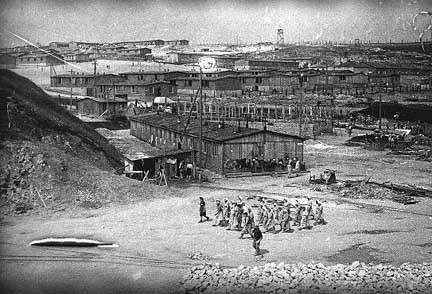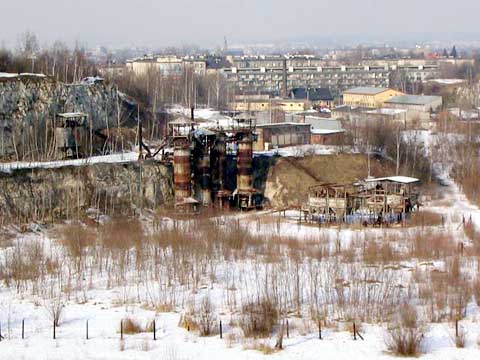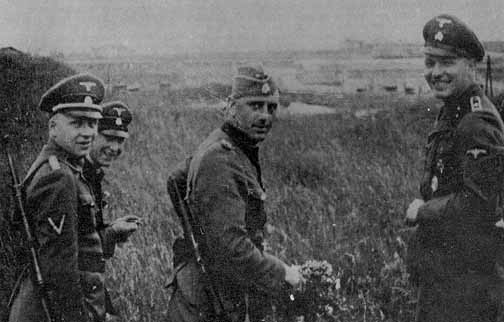Plaszow Concentration Camp

Plaszow Camp in Podgorze
district of Krakow
If it were not for the Stephen Spielberg
movie, Schindler's List, the story of the Nazi concentration
camp at Plaszow, located in the Podgorze district, 10 kilometers
outside the city center of Krakow, might never have become known
to the average American. Because of the popularity of this movie,
every school child in America, and probably every school child
in the rest of the world, knows of this otherwise insignificant
camp and the cruelty of its Commandant, Amon Goeth.
The photo above shows the Plaszow camp. Prisoners who were in the punishment detail had to do hard labor in a quarry. There were also factories in the camp where the prisoners worked.
 Plaszow quarry in the
Podgorze district of Krakow
Photo Credit: Simon
Robertson
Plaszow quarry in the
Podgorze district of Krakow
Photo Credit: Simon
Robertson
In March 1941, the Jews in the Krakow area were put into a walled ghetto in Podgorze, a district of Krakow. This ghetto was depicted in the movie, Schindler's List, but the actual scenes were filmed nearby in the old Jewish quarter called Kazimierz because there are modern buildings in Podgorze now, while Kazimierz was still in its original state.
The next stage of the Final Solution for the Krakow Jews was the liquidation of the Podgorze ghetto and the transportation of the remaining Jews to the forced labor camp at Plaszow on March 13 and 14, 1943. Before the liquidation of the ghetto, there were 2,000 prisoners at the Plaszow camp, all of them Jews. Afterwards, the camp population rose to 8,000. At this point, Plaszow was still not a concentration camp, but a penal labor camp under the jurisdiction of local SS men in the General Government, as the central section of occupied Poland was called by the Nazis. According to the novel "Schindler's Ark," it was because Plaszow was a labor camp, under local authority, that the random killing of prisoners by Amon Goeth did not command much attention among the top brass. The novel "Schindler's Ark" explains that executions and floggings at all of the concentration camps had to be approved by the central administrative office in Berlin, but not at the labor camps.
Until the middle of 1943, all the prisoners
at the Plaszow forced labor camp were Jews. In July 1943, a separate
section was fenced off for Polish prisoners who were sent to
the camp for breaking the laws of the German occupational government.
Polish prisoners served their sentences and were then released
from the prison. The Jews remained in the camp indefinitely.
Many Jews were sent on to the Auschwitz concentration camp, only
60 kilometers southwest of Krakow.
The Schindler Jews at first lived in the Plaszow camp and walked 2.5 kilometers to and from Schindler's enamelware factory each day. The factory was in an ordinary-looking, modern, but dreary building in Krakow. Then Schindler bribed Plaszow Commandant Amon Goeth to let his workers move into barracks which he built in the courtyard of the factory. Schindler himself lived in a nondescript gray apartment building close to his factory. When I visited Krakow in 1998, Schindler's factory building was being used by an electronics factory called Toplar. It is now a Museum for tourists.
There were many small sub-camps, such
as the Schindler factory, in the Nazi labor camp system, but
none where the prisoners were so well treated. The Nazis provided
food for the Schindler Jews, but Schindler spent the equivalent
of $360,000 to provide extra food, which he bought on the black
market, for his prisoners.
Amon Goeth became the Commandant of Plaszow
in February 1943; he held this position until September 1944
when he was arrested by the SS for stealing from the camp warehouses.
He was put into prison by the SS but was then released and sent
to a hospital because he was suffering from diabetes. He was
arrested by American troops after the war and extradited to Poland.
According to the charges at his trial before the Supreme Court
in Poland after the war, Goeth had stolen articles that the prisoners
had brought with them to the camp. At his trial, Goeth was charged
with the murder of 2,000 Jews who were killed during the liquidation
of the Podgorze ghetto which he supervised; he was also held
responsible for 8,000 deaths in the Plaszow camp, although he
was not charged with personally killing anyone.
The old photograph below shows the SS
soldiers who were on the camp staff. In the photo, the soldier
in the middle is picking wild flowers that grow abundantly in
this area, which is, in fact, now a nature preserve for rare
herbs and flowers.
 SS soldiers on the
staff at Plaszow concentration camp
SS soldiers on the
staff at Plaszow concentration camp
|